Shravanabelagola
Shravanabelagola (Śravaṇa Beḷagoḷa) is a town located near Channarayapatna of Hassan district in the Indian state of Karnataka and is 144 km from Bangalore. The Gommateshwara Bahubali statue at Shravanabelagola is one of the most important tirthas (pilgrimage destinations) in Jainism, one that reached a peak in architectural and sculptural activity under the patronage of Western Ganga dynasty of Talakad. Chandragupta Maurya is said to have died here in 298 BCE after he became a Jain monk and assumed an ascetic life style.[1]
Shravanabelagola | |
|---|---|
Town | |
 The Gommateshwara statue dated 978-993 on Vindhyagiri Hill | |
 Shravanabelagola Shravanabelagola/ಶ್ರವಣಬೆಳಗೊಳ | |
| Coordinates: 12.859°N 76.489°E | |
| Country | India |
| State | Karnataka |
| District | Hassan |
| Elevation | 871 m (2,858 ft) |
| Time zone | UTC+5:30 (IST) |
| Part of a series on |
| Jainism |
|---|
 |
|
Jain prayers |
|
Ethics |
|
Major sects |
|
Texts |
|
Festivals
|
|
|
Location
Shravanabelagola is located at 11 km to the south-east of Channarayapatna in the Channarayapatna taluk of Hassan district of Karnataka. It is at a distance of 51 km south-east of Hassan, Karnataka, the district centre. It is situated at a distance of 12 km to the south from the Bangalore-Mangalore road (NH-75), 18 km from Hirisave, 78 km from Halebidu, 89 km from Belur, 83 km from Mysuru, 144 km from Bangalore, the capital of Karnataka and 222 km from Mangalore.
Sacred places are spread over two hills, Chandragiri and Vindyagiri, and also among the villages at the foothills.
Etymology
Shravanabelagola "White Pond of the Shravana" is named with reference to the colossal image of Gommaṭa - the prefix Śravaṇa serves to distinguish it from other Belagolas with the prefixes Hale- and Kodi-, while Beḷagoḷa "white pond" is an allusion to the pond in the middle of the town. The Sanskrit equivalents Śvetasarovara, Dhavalasarovara and Dhavalasarasa used in the inscriptions that support this meaning.
Some inscriptions mention the name of the place as Beḷgoḷa, which has given rise to another derivation from the plant Solanum ferox (hairy-fruited eggplant). This derivation is in allusion to a tradition which says that a pious old woman completely anointed the colossal image with the milk brought by her in a gullakayi or eggplant. The place is also designated as Devara Beḷgoḷa "White Pond of the God" and Gommaṭapuram "city of Gommaṭa" in some epigraphs.
History
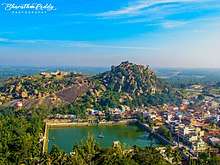
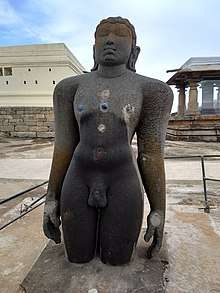
Shravanabelagola has two hills, Chandragiri and Vindhyagiri. Acharya Bhadrabahu and his pupil Chandragupta Maurya are believed to have meditated there.[3][4] Chandragupta Basadi, which was dedicated to Chandragupta Maurya, was originally built there by Ashoka in the third century BC. Chandragiri also has memorials to numerous monks and Śrāvakas who have meditated there since the fifth century AD, including the last king of the Rashtrakuta dynasty of Manyakheta. Chandragiri also has a famous temple built by Chavundaraya.[5]
The 58-feet tall monolithic statue of Gommateshwara is located on Vindyagiri Hill.[6] It is considered to be the world's largest monolithic statue. The base of the statue has an inscriptions in Prakrit, dating from 981 AD. The inscription praises the king who funded the effort and his general, Chavundaraya, who erected the statue for his mother. Every twelve years, thousands of devotees congregate here to perform the Mahamastakabhisheka, a spectacular ceremony in which the statue is anointed with Water, Turmeric, Rice flour, Sugar cane juice, Sandalwood paste, saffron, and gold and silver flowers.[7] Recently Mahamastakabhisheka was held in 2018 during feb month. The next Mahamastakabhisheka will be held in 2030.[8] The statue is referred to as Gommateshwara by Kannadigas, but the Jains refer to the same as "Bahubali".
Shravanabelagola, nestled by the Vindhyagiri and Chandragiri Hills, protected by the monolith Bhagwan Bahubali, and home to over 2,300 years of Jain heritage, is a veritable picture postcard of our history and heritage spanning the centuries. In the town of Shravanabelagola, stands a colossal rock-cut statue of Lord Gommateshwara Shri Bahubali. About eight hundred odd inscriptions which the Karnataka Archeological Department has collected at the place are mostly Jaina and cover a very extended period from 600 to 1830 A.D. Some refer even to the remote time of Chandragupta Maurya and also relate the story of the first settlement of Jains at Shravanabelagola. That this village was an acknowledged seat of learning is proved from the fact that a priest from here named Akalanka was in 788 A.D. summoned to the court of Himasitala at Kanchi where having confuted the Buddhists in public disputation, he was instrumental in gaining their expulsion from the South of India to Ceylon.[9][10]
Inscriptions
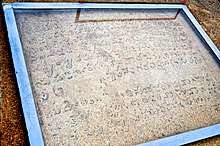
More than 800 inscriptions have been found at Shravanabelagola, dating to various times from 600 AD to 1830 AD. A large number of these are found in the Chandragiri and the rest can be seen in the Vindhyagiri Hill and the town. Most of the inscriptions at the Chandragiri date back before the 10th century. These inscriptions include texts in the Kannada. The second volume of Epigraphia Carnatica, written by B. Lewis Rice, is dedicated to the inscriptions found here. It is said to be the oldest Konkani inscription. The inscriptions are written in Purvahalagannada (Ancient Kannada) and Halegannada (Old Kannada) characters. Some of these inscriptions mention the rise and growth in power of the Western Ganga Dynasty, the Rashtrakutas, the Hoysala Empire, the Vijayanagara Empire and the Wodeyar dynasty. These inscriptions have helped modern scholars to understand the nature and development of the Kannada language and its literature.[11]
On August 5, 2007, the statue at Shravanabelagola was voted by the readers of Times of India as the first of the Seven Wonders of India.[12] 49% votes went in favor of the statue.
Basadi

1. Akkana Basadi: This was built in 1181 A.D. Akkana Basadi has 23rd Tirthankara Parshwanath as main deity of the temple.
2. Chandragupta basadi: This was established in the 9th century. The middle cell of this temple has the figure of Parshvanatha, the one to the right the figure of Padmavathi and the one to the left the figure of Kushmandini, all in a seated posture.
3. Shantinatha Basadi:This temple is dedicated to Shantinatha. It was built around 1200 A.D.
4. Parshwanatha Basadi: This is a beautiful structure with decorated outer walls. The image of Parshwanatha is the tallest on the hill which is 18 feet in height. The manastambha (pillar) is sculptured on all four sides which contains the figure of Padmavathi on the south, Yaksha on the east, seated Kushmandini on the north and a galloping horseman on the west. The pillars in the navaranga are of round Ganga type with bell, vase and wheel mouldings.
5. Kattlae Basadi: This is situated to the left of Parshwanatha Basadi and in fact this is the biggest of all the Basadis on this hill. Kattlae Basadi has first Jain Tirthankara Rishabhnatha as main deity of the temple. Here one finds the image of Adinatha Thirthankara and also of Pampavathi in the Kaisale.
6. Chandraprabha Basadi: It is dedicated to the worship of the 8th Tirthankara, Chandraprabha. The images of Shyama and Jwalamalini, Yaksha and Yakshi are to be found.The basadi is a brick structure raised over a stone base. This temple might be one of the oldest on the hill and its date would be about 800 A.D. It is said to have been constructed by the Ganga King Shivamara II.
7. Suparshwanatha Basadi: Seven headed serpent is carved over the head of the Suparshvanatha image.
8. Chamundaraya Basadi: is the finest and one of the largest temples on the hill. It is also known as Chavundaraya Basadi. It is dedicated to Neminatha, the 22nd Tirthankara. The sukhanasi consists of good figures of Sarvahna and Kushmandini, the yaksha and yakshi of Neminatha. It is dated back to 982 A.D.
Mahamastakabhisheka
-01.jpg)
The Mahamastakabhisheka (Grand Consecration/The Great Indian Festival), refers to the abhiṣheka (anointment) of the Jain images when held on a large scale. The most famous of such consecrations is the anointment of the Bahubali Gommateshwara Statue located at Shravanabelagola. It is an important Jain festival held once in every 12 years. It is an integral part of the ancient and composite Jain tradition. The festival is held in veneration of a 17.3736 metres (57.000 ft) high monolithic statue of the Siddha Bahubali. The anointing last took place in February 2018, and the next ceremony is going to take place in 2030.[13] During this festival, the statue is then bathed and anointed with libations such as milk, sugarcane juice, and saffron paste, and sprinkled with powders of sandalwood, turmeric, and vermilion.[14]
The event has been attended by multiple political personalities including Krishna-Rajendra Wodeyar in 1910, and Narendra Modi and Ramnath Kovind in 2018.[15]
Jain Temples near Shravanbelagola
- Jinanathapura Ancient Jain Temples - 3 Kilometers from Shravanbelagola
- Kambadahalli Ancient Jain Temples - 18 Kilometers from Shravanbelagola
- Aratipura[16] Jain Heritage Center & Temples - 100 Kilometers from Shravanbelagola
- Mayasandra[17] Ancient Digambar Jain Mandir - 55 Kilometers from Shravanbelagola
- Markuli Ancient Jain Temple - 45 Kilometers from Shravanbelagola
Other notable things
Shravanabelagola is the seat of the ancient Bhattaraka Matha, belonging to the Desiya Gana lineage of Mula Sangh, from the Digambara monastic tradition. The Bhattarakas are all named Charukeerti. Bahubali College of Engineering is an educational institute at Shravaṇabeḷagoḷa.
Halebidu is also part of the route followed by the luxury tourist train, the Golden Chariot.[18]
The Govt of Karnataka showcased the statue of Lord Gometashwara at the Republic Day (India) Parade of 2005 and it received the first prize from the then President of India Hon'ble Dr. A. P. J. Abdul Kalam
Notable people
- Bhattaraka Charukeerthi Swamiji, pontiff of the Shravanabelagola Jain Mutt
Photo gallery
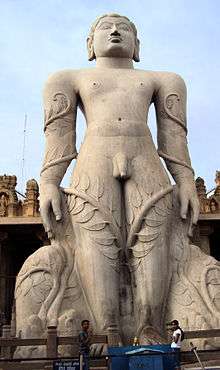
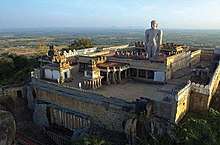 Aerial view of Gommateshwara statue
Aerial view of Gommateshwara statue Odegal Basadi
Odegal Basadi Miniature version of the Gommateshwara statue
Miniature version of the Gommateshwara statue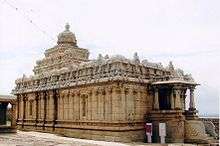 Chavundaraya Basadi
Chavundaraya Basadi- Basadi in Sravanabelgola
 Painting inside Jain Math
Painting inside Jain Math
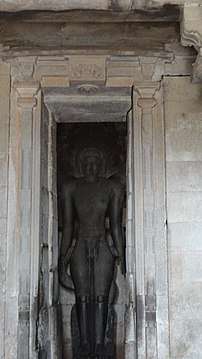 18 feet idol of Parsvanatha in Parsvanatha Basadi
18 feet idol of Parsvanatha in Parsvanatha Basadi An Old Photograph (c. 1899)
An Old Photograph (c. 1899)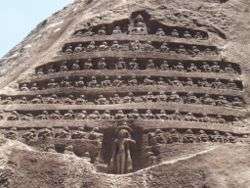 Relief of tirthankar images
Relief of tirthankar images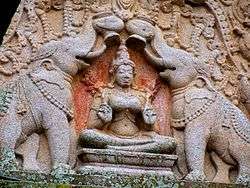 Image of Gaja Lakshmi at entrance of the temple
Image of Gaja Lakshmi at entrance of the temple
See also
| Wikimedia Commons has media related to Shravanabelagola. |
Notes
- Vir Sanghvi, "Rude Travel: Down The Sages", Hindustan Times
- Jain Pooja-Kavya: Ek Chintan. ISBN 9788126308187.
- Sangave 2001, p. 204.
- S. Settar, Inviting Death: Historical experiments on sepulchral hill, Karnatak University, Dharwar, 1986
- Biswas 2014, p. 275.
- "Delegates enjoy a slice of history at Śravaṇa Beḷgoḷa", The Hindu, Chennai, Staff Correspondent, 1 January 2006
- Kumar, Brajesh (2003), Pilgrimage Centres of India, Diamond Pocket Books (P) Ltd., p. 199, ISBN 9788171821853
- "Mahamastakabhisheka works will be completed on time: A. Manju". 17 August 2017 – via www.thehindu.com.
- B. L. Rice 2001, p. 366.
- Lewis Rice 1985, p. 12.
- Introduction in Epigraphia Carnatica Vol.2 Institute of Kannada Studies, Mysore, 1972.
- "And India's 7 wonders are", The Times Of India, 5 August 2007
- Correspondent, TNN (8 February 2006). "Mahamastakabhisheka of Bahubali begins today". The Times of India. Retrieved 19 December 2012.
- Kumar, Brajesh (2003), Pilgrimage Centres of India, Diamond Pocket Books (P) Ltd., p. 199, ISBN 9788171821853
- "Bahubali Mahamastakabhisheka Mahotsav: Here is the history of the Jain festival PM Modi attended today", The Indian Express, 19 February 2018
- "Aratipura Archives - Jain Heritage Centres". Jain Heritage Centres. Retrieved 29 December 2017.
- "Mayasandra - Jain Heritage Centres". Jain Heritage Centres. 14 December 2011. Retrieved 29 December 2017.
- "Pride of the South".
References
- Karnataka State Gazetteer 1983
- Rice, B. Lewis (1889), Inscriptions at Sravana Belgola: a chief seat of the Jains, (Archaeological Survey of Mysore), Bangalore: Mysore Govt. Central Press
- Sangave, Vilas Adinath (2001), Facets of Jainology: Selected Research Papers on Jain Society, Religion, and Culture, Mumbai: Popular Prakashan, ISBN 978-81-7154-839-2
- Biswas, Subhash C. (2014), India the Land of Gods, Partridge Publishing, ISBN 9781482836547
External links
| Wikimedia Commons has media related to Shravanabelagola. |
